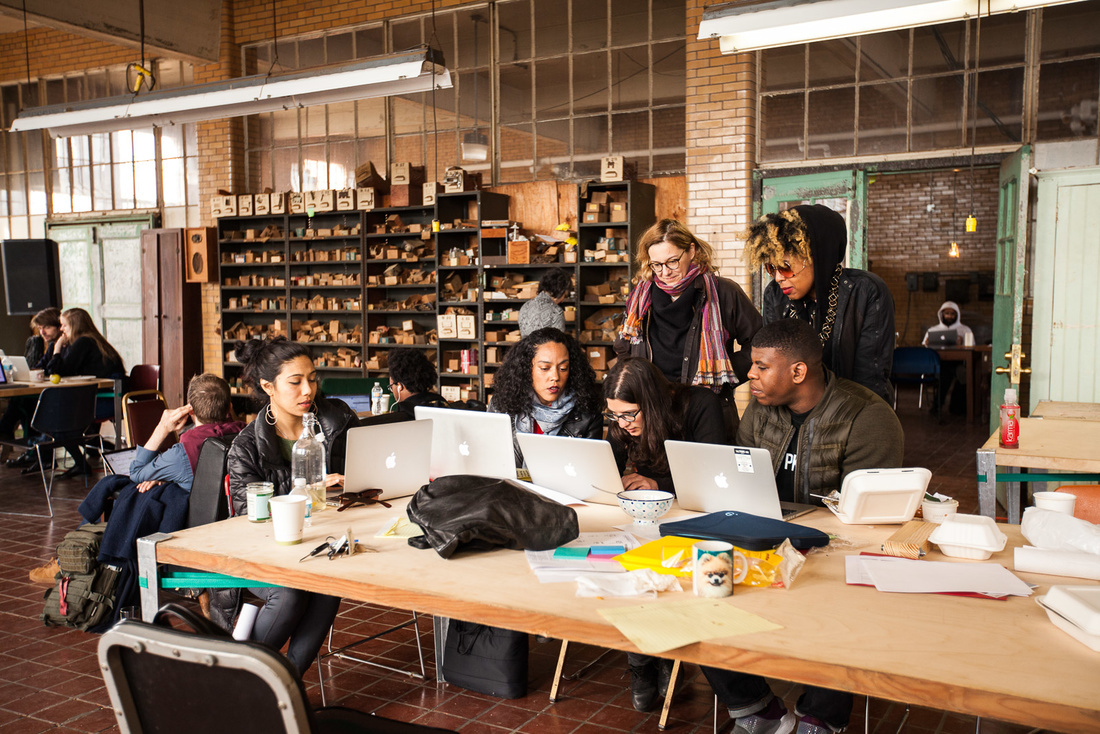9 Ways Museums Can Engage the Creative Class
 A group of fellows prepare their presentation at Ideas City Detroit. Photo by Marta Xochilt Perez for Artsy.
A group of fellows prepare their presentation at Ideas City Detroit. Photo by Marta Xochilt Perez for Artsy.
In a previous essay, I addressed the challenges facing museums and art institutions, and in particular the fierce competition for funding resources, arguing the solution must include a broader base of outside support and a wider definition of “resources.” Here I consider alternative approaches to securing support that goes well beyond dollars, and make the case for soliciting new resources to support new capabilities.
One caveat: The ideas presented here are meant to catalyze discussion and spur debate. It’s neither my intention nor my ambition to predict the future of art museums. I’m examining challenges and choices, and issuing a call for more experimentation, better efforts at measurement, and a greater willingness to learn from mistakes. My hope is to help advance the dialogue about how to improve the institutional art ecosystem.
The following nine recommendations are a start. These are by no means the only plausible solutions, but do merit consideration, adoption, and subsequent evaluation. The right recipe to achieve longevity and stronger performance will vary from institution to institution, and no single technique or program will prove sufficient. Only a combination of these efforts, employed or pursued synchronistically, will unlock and accelerate success. If I’m wrong, I hope my mistakes help us move closer towards what is “right” for each institution and its needs.
The guiding principle is: Institutions should adopt an all-available resources mentality, treating all types of contributions as "currency" that they can solicit, bank, and deploy. In lieu of spending cash on external services or capabilities, it’s essential to secure contributions of service that address critical needs and augment current capabilities. Here are a few with which to start:
Design Services
Gifts from top-tier design agencies—in the form of billable hours or tightly scoped projects—can deliver industry-leading work across multiple channels: digital and brand strategy, logo redesign and typographic explorations, physical marketing assets, new web and mobile products, AR/VR experiences, experiments with audio, or offline immersive programming. This is but a hint of how museums might solicit the support of specialty agencies.
Digital Marketing Capabilities
Donations from marketing agencies, either in the form of ad support or media amplification, can prove enormously beneficial to awareness and engagement efforts. Museums can offset spending related to digital programming by soliciting donations for these services, ideally from industry-leading practitioners. By partnering with specialists in the field, museums can optimize multi-channel marketing, better manage campaigns, achieve sharper customer insights and target audiences more effectively, or improve ad performance. Services like this, however, present their own complexities: Museums must ensure that their pro bono engagements don’t violate contract terms with the donor’s competitor. Museums also must ensure that they retain copyright controls and are not liable for expensive future maintenance costs.
Legal and Accounting Services
This might be far the most valuable (and least leveraged) service gifted to institutions. In addition to simple turn-key accounting services, senior-level strategic accounting expertise which helps museums identify new approaches to structuring gifts could help institutions better identify opportunities for donors and for themselves. There are myriad new accounting methods or tax instruments uniquely suited to 1) encourage and incentivize charitable giving or 2) reinvest assets without incurring burdensome tax liability. Other non-profits use sophisticated tax and legal advice with great success.
That said, tax reform is currently a priority for the Trump administration, and changing tax laws may present new challenges in soliciting or structuring charitable donations.
Founder Equity & Vesting Gifts
Founder equity and vesting gifts—in which a museum receives stock in a privately held, speculative venture at an early stage—should be pursued with greater vigor, and far more regularly. More important than any potential payout is how this donation engages the tech community along lines with which they are already familiar. Of course, potential payouts can be wonderful (like Facebook’s infamous stock-in-lieu of cash compensation to graffiti artist David Choe). More advanced practitioners of tech-friendly fundraising might move past matching-grant scenarios (dollar-for-dollar contributions from a foundation or donor for every outside dollar raised) and weave in triggers or ratchets (payouts or pricing mechanisms tied to equity grants) to encourage participation and improve outcomes.
Food & Beverage
Museums can leverage their highly educated, upwardly mobile audiences to persuade restaurateurs and nutrition entrepreneurs to gift products or experiences. Museums can attract new and unaffiliated audiences, based on the short-term nature of the offer and the popular pursuit of gastronomic novelty; the donor restaurants or food companies gain exposure to a valuable demographic.
Publishing and Promotional Support
It’s time to get cozier with media. More interviews. More profiles. Features. Lists. Best of’s. In order to honor editorial discretion, coverage cannot be guaranteed, but deals with publishers can be negotiated to guarantee inclusion of some kind, or to secure steeply discounted deals for branded content—anything to maximize exposure. Imagine, for instance, an exclusive artist insert or a collectible tear-out edition, appearing in a print issue of Surface Magazine with an accompanying web-based digital component; or an exclusive art film released on NOWNESS; or a limited-edition supplement to Interview Magazine, devoted entirely to a bi- or triennial; even an AR-enabled page spread in a print issue of BlackBook, revealing digital sculptures or multi-sensory programming. Further exploration (both in terms of concept and cost) is needed with publishers and project-specific museum donors.
Evolving Education
Education technology is a fast-expanding category, one in which museums and art institutions have a natural advantage, thanks to their existing education departments and museum mission statements in general. New offers might take the form of an accelerator program or incubator like NEW INC at the New Museum; specialized coursework or non-accredited classes like Masterclass; exclusive lectures, early childhood arts education, or continuing education for mid-, late-, or post-career professionals. One or any of these could be revenue-positive. The principal remaining question: Do museums have the bandwidth and brand credibility required to offer new programs in fine art or adjacent fields, and expertise required to operate their own General Assembly, Codecademy, or Sotheby’s Institute? Quite possibly, yes.
Sales and eCommerce
Commerce can be a pain, but also offers a chance to raise revenue and extend the brand awareness of an institution. Two things to keep in mind: Focus on the four P’s of selling (Product, Price, Packaging, and Promotion), and, where possible, enlist the support of experienced entrepreneurs or retailers to help create commerce and e-commerce solutions that don’t require massive provisions of time or capital. A few popular examples: the Librairie boutique du Musée national Picasso, the Shop at Museum der Dinge in Berlin (although both are missing e-commerce sites, a potential avenue for growth). The Museum of Modern Art’s design store is an impressive extension of the institution’s world-renowned design department, and offers visitors (and online shoppers) the chance to enjoy curated offerings while supporting a museum with their purchases.
Ideally, inventory should be tied to, inspired by, or related to current shows or permanent collections, but in every case, commerce requires an honest assessment of internal strengths, resources, capabilities, talent, physical real estate, and other exploitable advantages.
Network Access and Bundled Benefit Programs
Just as grocery stores or perfume counters bundle items to promote visibility and sell-through, there are a bevy of untapped opportunities for museums and art institutions to bundle unique purchase and programming opportunities (including “mileage” or rewards programs) with hotel operators, membership clubs (of the digital and physical variety), private bank promotions, or deals with alumni networks, to name but a few. The costs have to be carefully calculated and controlled, a process that could benefit from direct input from industry specialists or special subcommittees.
In sum, ties between people or affiliations between people and organizations matter more than ever. This is particularly true as traditional identity erodes, old vetting methods expire, signals of approval change, and notions of authority or credibility shift in unfamiliar and often perplexing ways. What museums can offer people isn’t power but greater influence—formal affiliation with a museum, and the influence that comes with it, ought to be used as a recruitment tool. Separately, this case has to be made to individuals: that it’s not about what they “get” out of giving, but that giving itself, of your time, ideas, or connections, is critically important in its own right. Not just for altruistic dividends, but because the overall art and cultural ecosystems demand it—and the richness of their life depends on it. To make this case either less foggy or simply more palatable to both audiences, we need a new language for this kind of giving, receiving, supporting, and affiliating, as well as vibrant examples to envy—and then emulate. I don’t yet have the answer.
Ultimately, these tools will help museums save cash, positively change the way we think about them, alter the way they see themselves, and hopefully create a new range of programming opportunities for their audiences, for each of us, and for a world increasingly in need of bliss and a bit more divinity.
—Michael Phillips Moskowitz
Michael Phillips Moskowitz is an entrepreneur, art collector, and member of the New Museum’s NEW INC initiative advisory council.


No comments:
Post a Comment